Tesco Employee Motivation: Extrinsic & Intrinsic Factors Impact
VerifiedAdded on 2023/06/11
|13
|4547
|237
Literature Review
AI Summary
This literature review investigates the factors influencing employee motivation and retention at Tesco, focusing on both extrinsic and intrinsic motivational elements, and the role of company strategies. It critically evaluates the impacts of financial rewards, employee recognition, and career development (extrinsic factors) alongside building trust and respect (intrinsic factors) on staff motivation and retention. The review also assesses the effectiveness of Tesco's staff development programs in retaining and motivating employees. Utilizing secondary data sources, the study employs a quantitative research method to ensure measurable results. The review concludes with recommendations for Tesco to enhance employee motivation and retention.
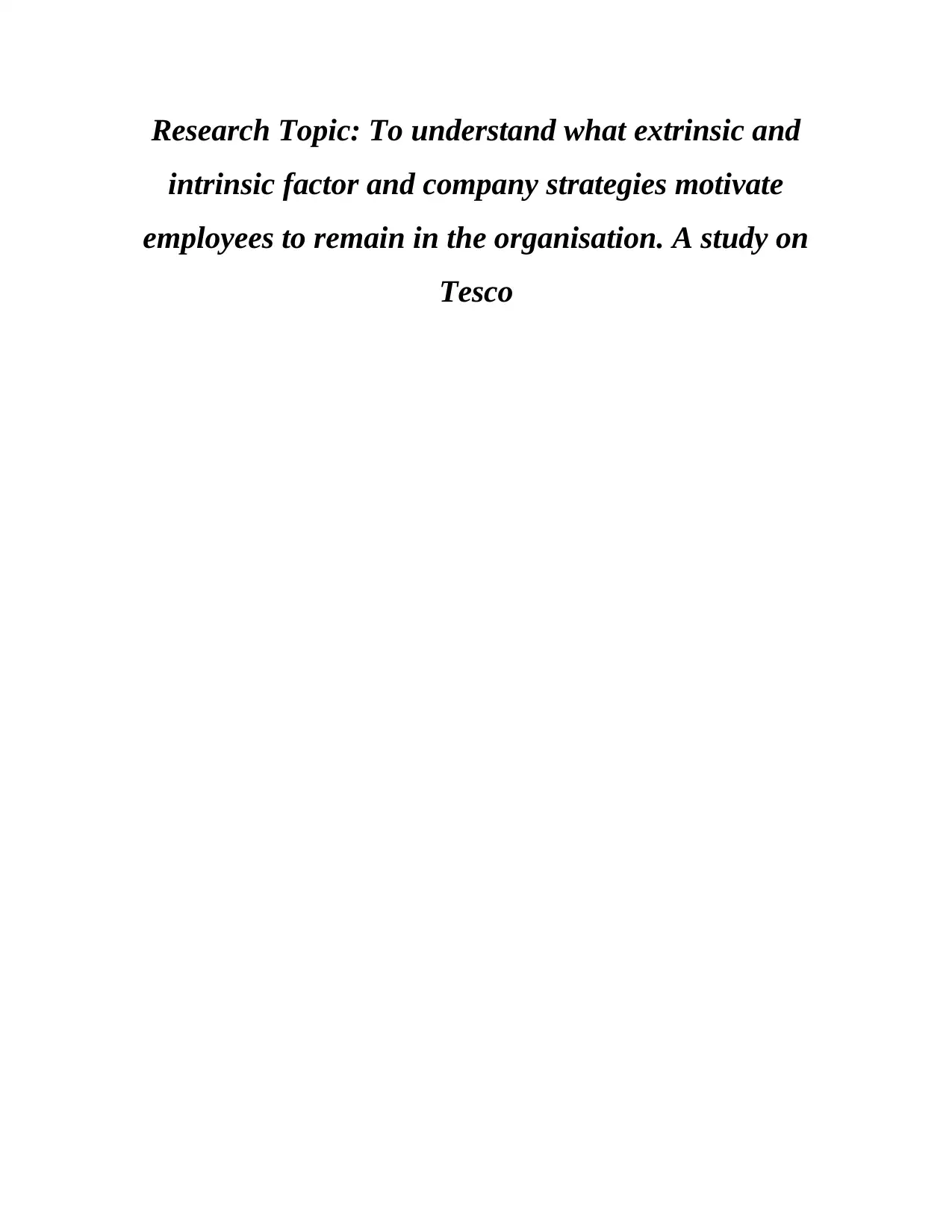
Research Topic: To understand what extrinsic and
intrinsic factor and company strategies motivate
employees to remain in the organisation. A study on
Tesco
intrinsic factor and company strategies motivate
employees to remain in the organisation. A study on
Tesco
Paraphrase This Document
Need a fresh take? Get an instant paraphrase of this document with our AI Paraphraser
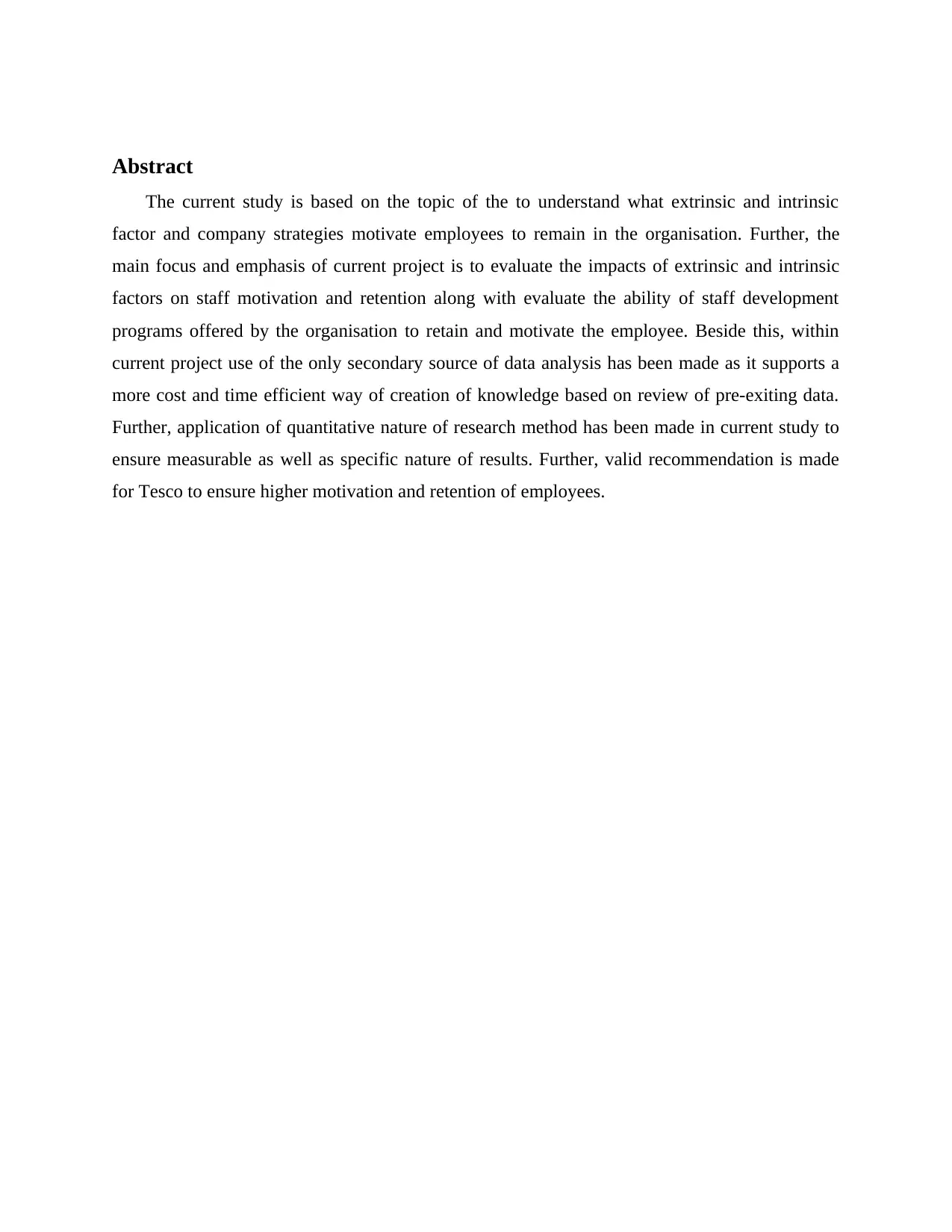
Abstract
The current study is based on the topic of the to understand what extrinsic and intrinsic
factor and company strategies motivate employees to remain in the organisation. Further, the
main focus and emphasis of current project is to evaluate the impacts of extrinsic and intrinsic
factors on staff motivation and retention along with evaluate the ability of staff development
programs offered by the organisation to retain and motivate the employee. Beside this, within
current project use of the only secondary source of data analysis has been made as it supports a
more cost and time efficient way of creation of knowledge based on review of pre-exiting data.
Further, application of quantitative nature of research method has been made in current study to
ensure measurable as well as specific nature of results. Further, valid recommendation is made
for Tesco to ensure higher motivation and retention of employees.
The current study is based on the topic of the to understand what extrinsic and intrinsic
factor and company strategies motivate employees to remain in the organisation. Further, the
main focus and emphasis of current project is to evaluate the impacts of extrinsic and intrinsic
factors on staff motivation and retention along with evaluate the ability of staff development
programs offered by the organisation to retain and motivate the employee. Beside this, within
current project use of the only secondary source of data analysis has been made as it supports a
more cost and time efficient way of creation of knowledge based on review of pre-exiting data.
Further, application of quantitative nature of research method has been made in current study to
ensure measurable as well as specific nature of results. Further, valid recommendation is made
for Tesco to ensure higher motivation and retention of employees.
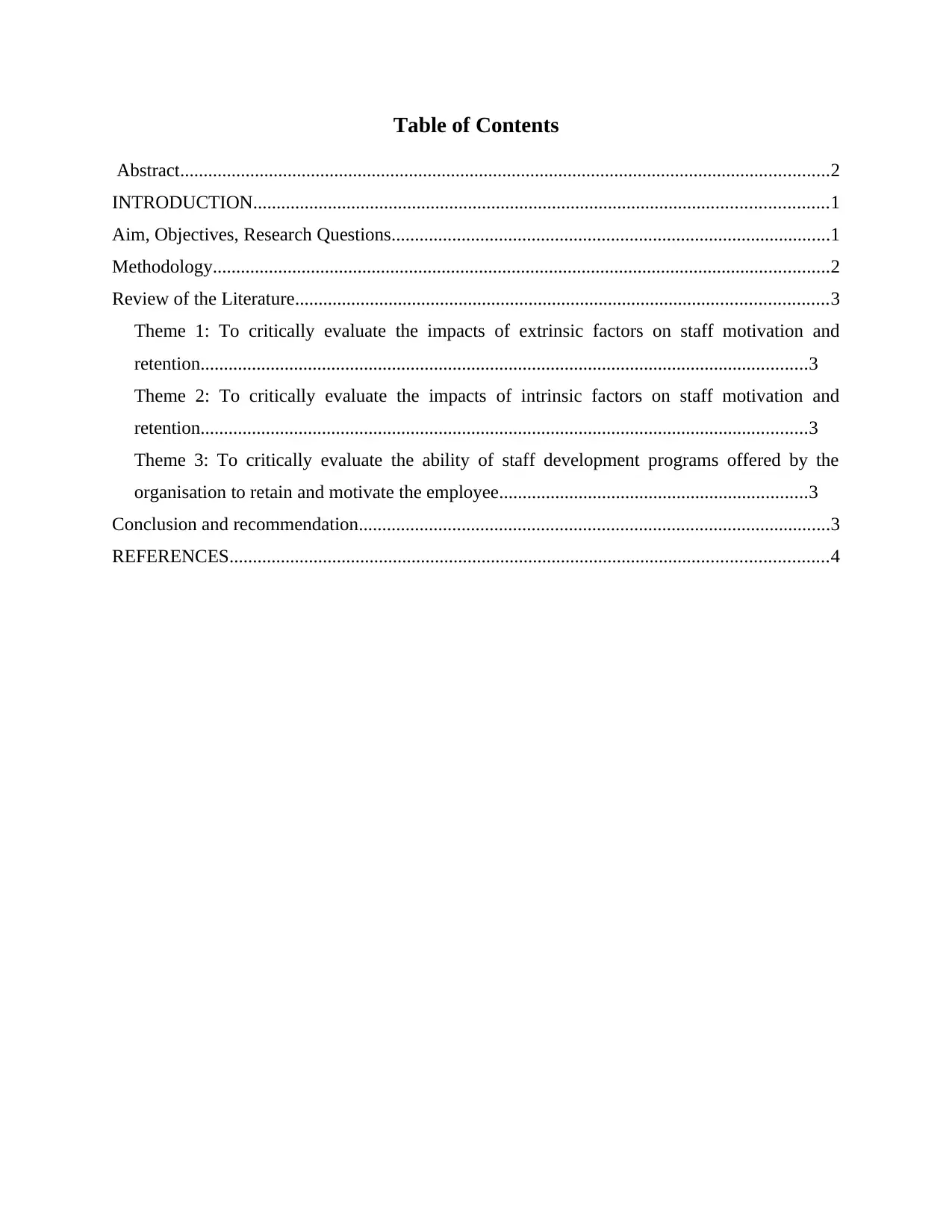
Table of Contents
Abstract...........................................................................................................................................2
INTRODUCTION...........................................................................................................................1
Aim, Objectives, Research Questions..............................................................................................1
Methodology....................................................................................................................................2
Review of the Literature..................................................................................................................3
Theme 1: To critically evaluate the impacts of extrinsic factors on staff motivation and
retention..................................................................................................................................3
Theme 2: To critically evaluate the impacts of intrinsic factors on staff motivation and
retention..................................................................................................................................3
Theme 3: To critically evaluate the ability of staff development programs offered by the
organisation to retain and motivate the employee..................................................................3
Conclusion and recommendation.....................................................................................................3
REFERENCES................................................................................................................................4
Abstract...........................................................................................................................................2
INTRODUCTION...........................................................................................................................1
Aim, Objectives, Research Questions..............................................................................................1
Methodology....................................................................................................................................2
Review of the Literature..................................................................................................................3
Theme 1: To critically evaluate the impacts of extrinsic factors on staff motivation and
retention..................................................................................................................................3
Theme 2: To critically evaluate the impacts of intrinsic factors on staff motivation and
retention..................................................................................................................................3
Theme 3: To critically evaluate the ability of staff development programs offered by the
organisation to retain and motivate the employee..................................................................3
Conclusion and recommendation.....................................................................................................3
REFERENCES................................................................................................................................4
⊘ This is a preview!⊘
Do you want full access?
Subscribe today to unlock all pages.

Trusted by 1+ million students worldwide
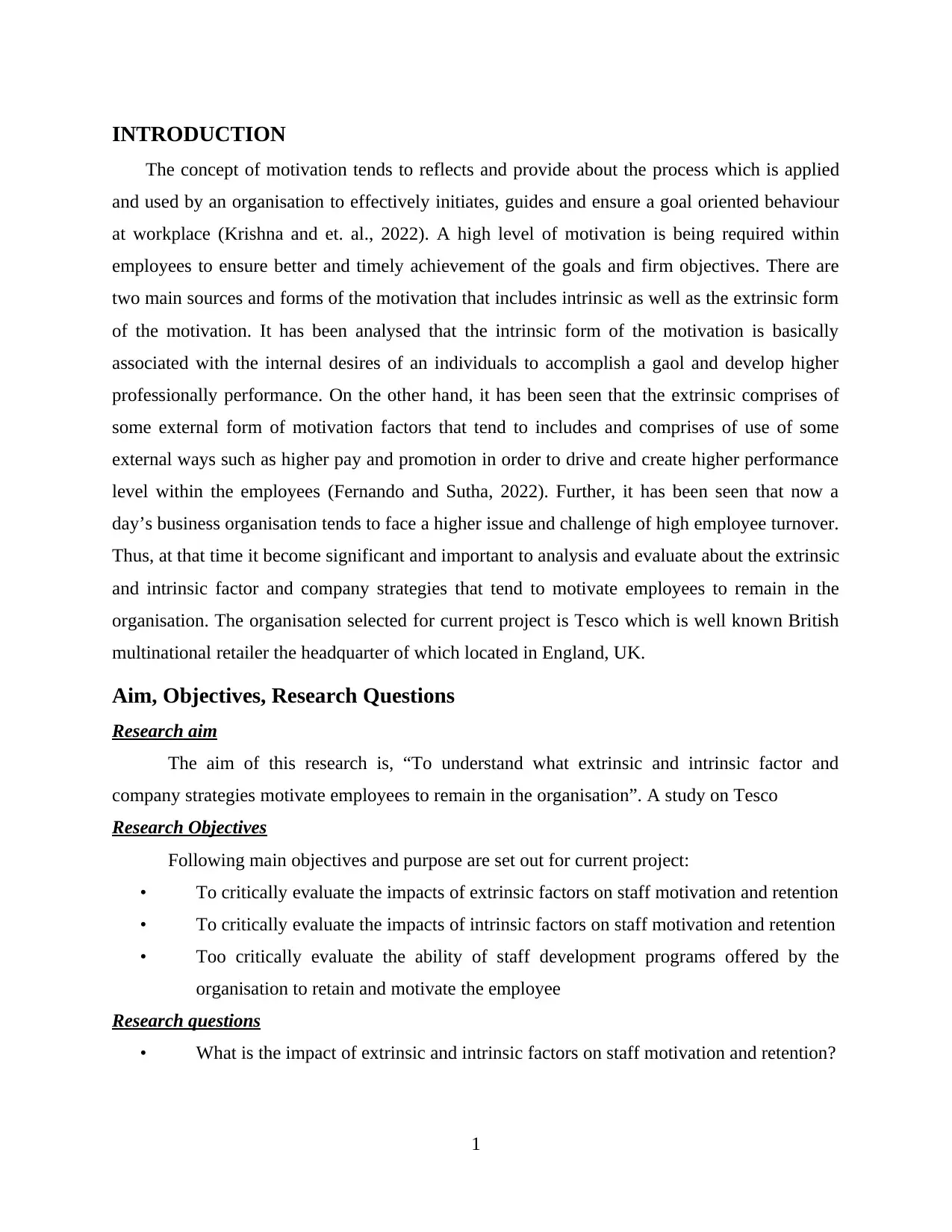
INTRODUCTION
The concept of motivation tends to reflects and provide about the process which is applied
and used by an organisation to effectively initiates, guides and ensure a goal oriented behaviour
at workplace (Krishna and et. al., 2022). A high level of motivation is being required within
employees to ensure better and timely achievement of the goals and firm objectives. There are
two main sources and forms of the motivation that includes intrinsic as well as the extrinsic form
of the motivation. It has been analysed that the intrinsic form of the motivation is basically
associated with the internal desires of an individuals to accomplish a gaol and develop higher
professionally performance. On the other hand, it has been seen that the extrinsic comprises of
some external form of motivation factors that tend to includes and comprises of use of some
external ways such as higher pay and promotion in order to drive and create higher performance
level within the employees (Fernando and Sutha, 2022). Further, it has been seen that now a
day’s business organisation tends to face a higher issue and challenge of high employee turnover.
Thus, at that time it become significant and important to analysis and evaluate about the extrinsic
and intrinsic factor and company strategies that tend to motivate employees to remain in the
organisation. The organisation selected for current project is Tesco which is well known British
multinational retailer the headquarter of which located in England, UK.
Aim, Objectives, Research Questions
Research aim
The aim of this research is, “To understand what extrinsic and intrinsic factor and
company strategies motivate employees to remain in the organisation”. A study on Tesco
Research Objectives
Following main objectives and purpose are set out for current project:
• To critically evaluate the impacts of extrinsic factors on staff motivation and retention
• To critically evaluate the impacts of intrinsic factors on staff motivation and retention
• Too critically evaluate the ability of staff development programs offered by the
organisation to retain and motivate the employee
Research questions
• What is the impact of extrinsic and intrinsic factors on staff motivation and retention?
1
The concept of motivation tends to reflects and provide about the process which is applied
and used by an organisation to effectively initiates, guides and ensure a goal oriented behaviour
at workplace (Krishna and et. al., 2022). A high level of motivation is being required within
employees to ensure better and timely achievement of the goals and firm objectives. There are
two main sources and forms of the motivation that includes intrinsic as well as the extrinsic form
of the motivation. It has been analysed that the intrinsic form of the motivation is basically
associated with the internal desires of an individuals to accomplish a gaol and develop higher
professionally performance. On the other hand, it has been seen that the extrinsic comprises of
some external form of motivation factors that tend to includes and comprises of use of some
external ways such as higher pay and promotion in order to drive and create higher performance
level within the employees (Fernando and Sutha, 2022). Further, it has been seen that now a
day’s business organisation tends to face a higher issue and challenge of high employee turnover.
Thus, at that time it become significant and important to analysis and evaluate about the extrinsic
and intrinsic factor and company strategies that tend to motivate employees to remain in the
organisation. The organisation selected for current project is Tesco which is well known British
multinational retailer the headquarter of which located in England, UK.
Aim, Objectives, Research Questions
Research aim
The aim of this research is, “To understand what extrinsic and intrinsic factor and
company strategies motivate employees to remain in the organisation”. A study on Tesco
Research Objectives
Following main objectives and purpose are set out for current project:
• To critically evaluate the impacts of extrinsic factors on staff motivation and retention
• To critically evaluate the impacts of intrinsic factors on staff motivation and retention
• Too critically evaluate the ability of staff development programs offered by the
organisation to retain and motivate the employee
Research questions
• What is the impact of extrinsic and intrinsic factors on staff motivation and retention?
1
Paraphrase This Document
Need a fresh take? Get an instant paraphrase of this document with our AI Paraphraser
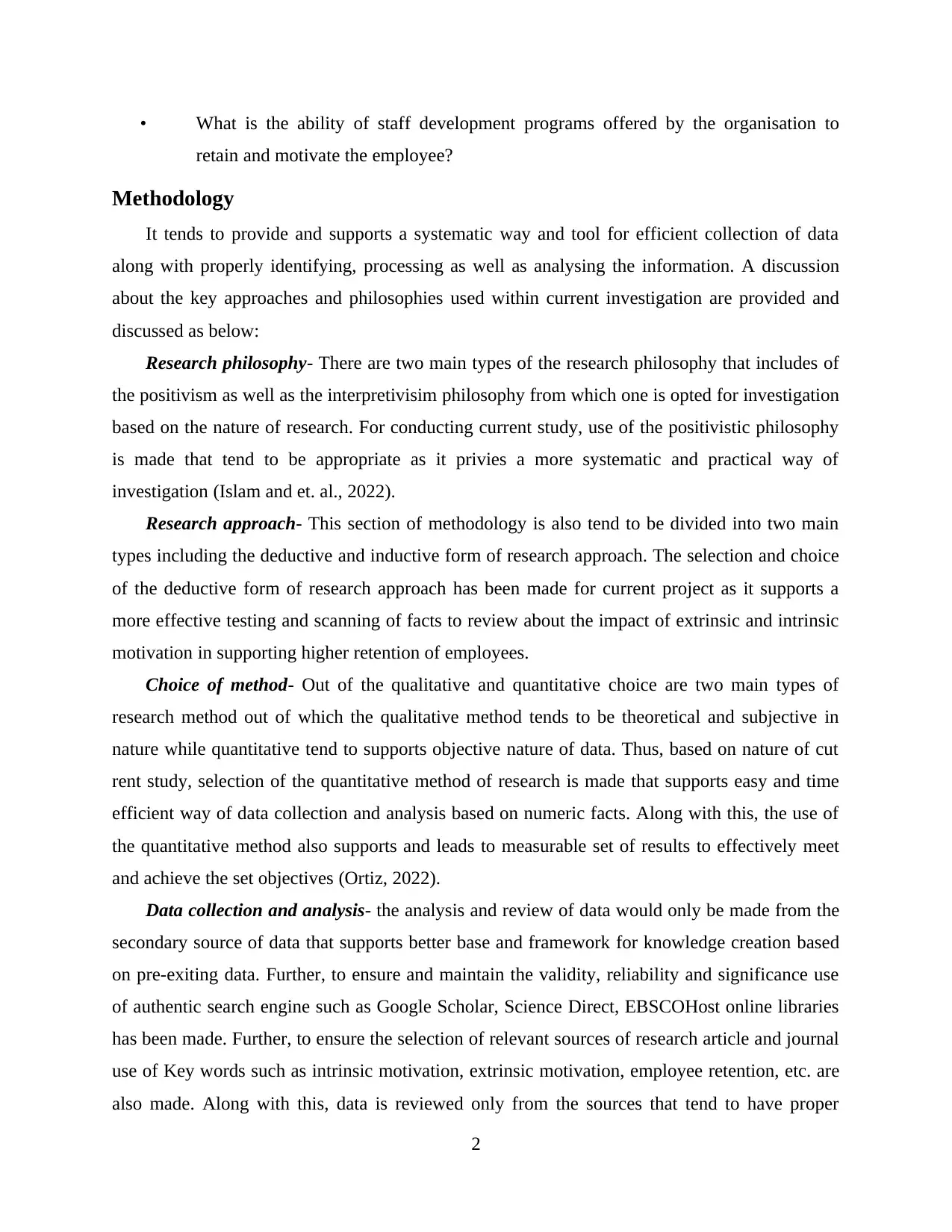
• What is the ability of staff development programs offered by the organisation to
retain and motivate the employee?
Methodology
It tends to provide and supports a systematic way and tool for efficient collection of data
along with properly identifying, processing as well as analysing the information. A discussion
about the key approaches and philosophies used within current investigation are provided and
discussed as below:
Research philosophy- There are two main types of the research philosophy that includes of
the positivism as well as the interpretivisim philosophy from which one is opted for investigation
based on the nature of research. For conducting current study, use of the positivistic philosophy
is made that tend to be appropriate as it privies a more systematic and practical way of
investigation (Islam and et. al., 2022).
Research approach- This section of methodology is also tend to be divided into two main
types including the deductive and inductive form of research approach. The selection and choice
of the deductive form of research approach has been made for current project as it supports a
more effective testing and scanning of facts to review about the impact of extrinsic and intrinsic
motivation in supporting higher retention of employees.
Choice of method- Out of the qualitative and quantitative choice are two main types of
research method out of which the qualitative method tends to be theoretical and subjective in
nature while quantitative tend to supports objective nature of data. Thus, based on nature of cut
rent study, selection of the quantitative method of research is made that supports easy and time
efficient way of data collection and analysis based on numeric facts. Along with this, the use of
the quantitative method also supports and leads to measurable set of results to effectively meet
and achieve the set objectives (Ortiz, 2022).
Data collection and analysis- the analysis and review of data would only be made from the
secondary source of data that supports better base and framework for knowledge creation based
on pre-exiting data. Further, to ensure and maintain the validity, reliability and significance use
of authentic search engine such as Google Scholar, Science Direct, EBSCOHost online libraries
has been made. Further, to ensure the selection of relevant sources of research article and journal
use of Key words such as intrinsic motivation, extrinsic motivation, employee retention, etc. are
also made. Along with this, data is reviewed only from the sources that tend to have proper
2
retain and motivate the employee?
Methodology
It tends to provide and supports a systematic way and tool for efficient collection of data
along with properly identifying, processing as well as analysing the information. A discussion
about the key approaches and philosophies used within current investigation are provided and
discussed as below:
Research philosophy- There are two main types of the research philosophy that includes of
the positivism as well as the interpretivisim philosophy from which one is opted for investigation
based on the nature of research. For conducting current study, use of the positivistic philosophy
is made that tend to be appropriate as it privies a more systematic and practical way of
investigation (Islam and et. al., 2022).
Research approach- This section of methodology is also tend to be divided into two main
types including the deductive and inductive form of research approach. The selection and choice
of the deductive form of research approach has been made for current project as it supports a
more effective testing and scanning of facts to review about the impact of extrinsic and intrinsic
motivation in supporting higher retention of employees.
Choice of method- Out of the qualitative and quantitative choice are two main types of
research method out of which the qualitative method tends to be theoretical and subjective in
nature while quantitative tend to supports objective nature of data. Thus, based on nature of cut
rent study, selection of the quantitative method of research is made that supports easy and time
efficient way of data collection and analysis based on numeric facts. Along with this, the use of
the quantitative method also supports and leads to measurable set of results to effectively meet
and achieve the set objectives (Ortiz, 2022).
Data collection and analysis- the analysis and review of data would only be made from the
secondary source of data that supports better base and framework for knowledge creation based
on pre-exiting data. Further, to ensure and maintain the validity, reliability and significance use
of authentic search engine such as Google Scholar, Science Direct, EBSCOHost online libraries
has been made. Further, to ensure the selection of relevant sources of research article and journal
use of Key words such as intrinsic motivation, extrinsic motivation, employee retention, etc. are
also made. Along with this, data is reviewed only from the sources that tend to have proper
2
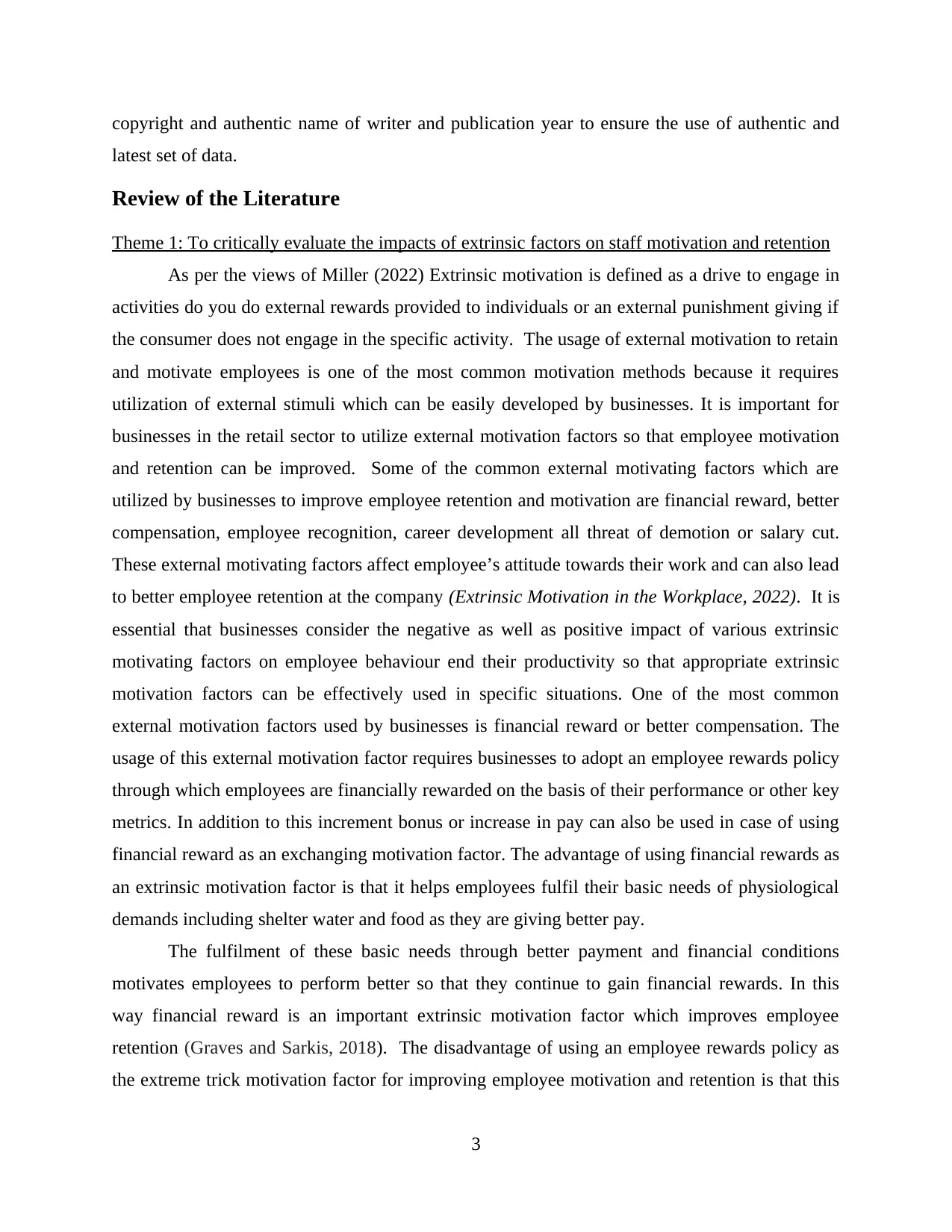
copyright and authentic name of writer and publication year to ensure the use of authentic and
latest set of data.
Review of the Literature
Theme 1: To critically evaluate the impacts of extrinsic factors on staff motivation and retention
As per the views of Miller (2022) Extrinsic motivation is defined as a drive to engage in
activities do you do external rewards provided to individuals or an external punishment giving if
the consumer does not engage in the specific activity. The usage of external motivation to retain
and motivate employees is one of the most common motivation methods because it requires
utilization of external stimuli which can be easily developed by businesses. It is important for
businesses in the retail sector to utilize external motivation factors so that employee motivation
and retention can be improved. Some of the common external motivating factors which are
utilized by businesses to improve employee retention and motivation are financial reward, better
compensation, employee recognition, career development all threat of demotion or salary cut.
These external motivating factors affect employee’s attitude towards their work and can also lead
to better employee retention at the company (Extrinsic Motivation in the Workplace, 2022). It is
essential that businesses consider the negative as well as positive impact of various extrinsic
motivating factors on employee behaviour end their productivity so that appropriate extrinsic
motivation factors can be effectively used in specific situations. One of the most common
external motivation factors used by businesses is financial reward or better compensation. The
usage of this external motivation factor requires businesses to adopt an employee rewards policy
through which employees are financially rewarded on the basis of their performance or other key
metrics. In addition to this increment bonus or increase in pay can also be used in case of using
financial reward as an exchanging motivation factor. The advantage of using financial rewards as
an extrinsic motivation factor is that it helps employees fulfil their basic needs of physiological
demands including shelter water and food as they are giving better pay.
The fulfilment of these basic needs through better payment and financial conditions
motivates employees to perform better so that they continue to gain financial rewards. In this
way financial reward is an important extrinsic motivation factor which improves employee
retention (Graves and Sarkis, 2018). The disadvantage of using an employee rewards policy as
the extreme trick motivation factor for improving employee motivation and retention is that this
3
latest set of data.
Review of the Literature
Theme 1: To critically evaluate the impacts of extrinsic factors on staff motivation and retention
As per the views of Miller (2022) Extrinsic motivation is defined as a drive to engage in
activities do you do external rewards provided to individuals or an external punishment giving if
the consumer does not engage in the specific activity. The usage of external motivation to retain
and motivate employees is one of the most common motivation methods because it requires
utilization of external stimuli which can be easily developed by businesses. It is important for
businesses in the retail sector to utilize external motivation factors so that employee motivation
and retention can be improved. Some of the common external motivating factors which are
utilized by businesses to improve employee retention and motivation are financial reward, better
compensation, employee recognition, career development all threat of demotion or salary cut.
These external motivating factors affect employee’s attitude towards their work and can also lead
to better employee retention at the company (Extrinsic Motivation in the Workplace, 2022). It is
essential that businesses consider the negative as well as positive impact of various extrinsic
motivating factors on employee behaviour end their productivity so that appropriate extrinsic
motivation factors can be effectively used in specific situations. One of the most common
external motivation factors used by businesses is financial reward or better compensation. The
usage of this external motivation factor requires businesses to adopt an employee rewards policy
through which employees are financially rewarded on the basis of their performance or other key
metrics. In addition to this increment bonus or increase in pay can also be used in case of using
financial reward as an exchanging motivation factor. The advantage of using financial rewards as
an extrinsic motivation factor is that it helps employees fulfil their basic needs of physiological
demands including shelter water and food as they are giving better pay.
The fulfilment of these basic needs through better payment and financial conditions
motivates employees to perform better so that they continue to gain financial rewards. In this
way financial reward is an important extrinsic motivation factor which improves employee
retention (Graves and Sarkis, 2018). The disadvantage of using an employee rewards policy as
the extreme trick motivation factor for improving employee motivation and retention is that this
3
⊘ This is a preview!⊘
Do you want full access?
Subscribe today to unlock all pages.

Trusted by 1+ million students worldwide
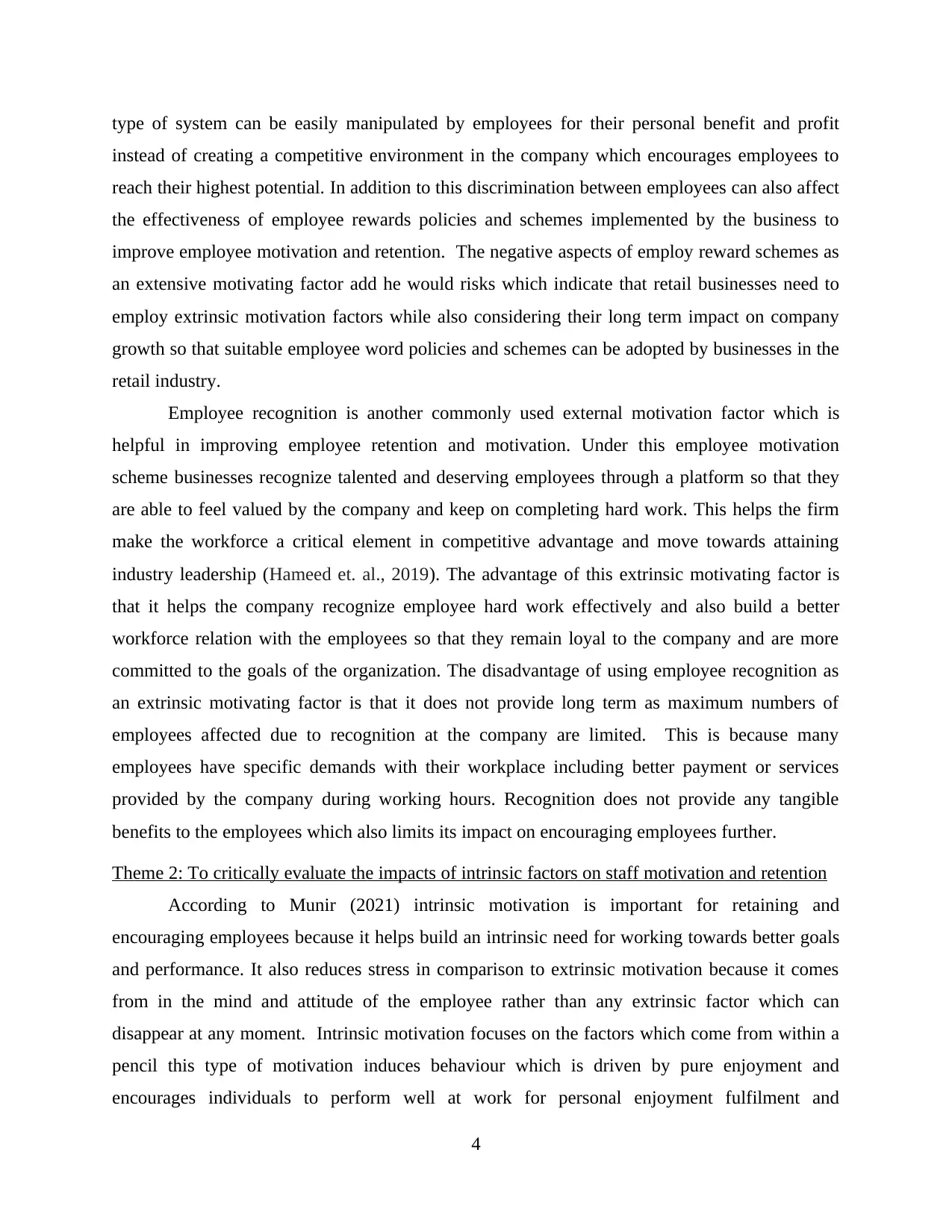
type of system can be easily manipulated by employees for their personal benefit and profit
instead of creating a competitive environment in the company which encourages employees to
reach their highest potential. In addition to this discrimination between employees can also affect
the effectiveness of employee rewards policies and schemes implemented by the business to
improve employee motivation and retention. The negative aspects of employ reward schemes as
an extensive motivating factor add he would risks which indicate that retail businesses need to
employ extrinsic motivation factors while also considering their long term impact on company
growth so that suitable employee word policies and schemes can be adopted by businesses in the
retail industry.
Employee recognition is another commonly used external motivation factor which is
helpful in improving employee retention and motivation. Under this employee motivation
scheme businesses recognize talented and deserving employees through a platform so that they
are able to feel valued by the company and keep on completing hard work. This helps the firm
make the workforce a critical element in competitive advantage and move towards attaining
industry leadership (Hameed et. al., 2019). The advantage of this extrinsic motivating factor is
that it helps the company recognize employee hard work effectively and also build a better
workforce relation with the employees so that they remain loyal to the company and are more
committed to the goals of the organization. The disadvantage of using employee recognition as
an extrinsic motivating factor is that it does not provide long term as maximum numbers of
employees affected due to recognition at the company are limited. This is because many
employees have specific demands with their workplace including better payment or services
provided by the company during working hours. Recognition does not provide any tangible
benefits to the employees which also limits its impact on encouraging employees further.
Theme 2: To critically evaluate the impacts of intrinsic factors on staff motivation and retention
According to Munir (2021) intrinsic motivation is important for retaining and
encouraging employees because it helps build an intrinsic need for working towards better goals
and performance. It also reduces stress in comparison to extrinsic motivation because it comes
from in the mind and attitude of the employee rather than any extrinsic factor which can
disappear at any moment. Intrinsic motivation focuses on the factors which come from within a
pencil this type of motivation induces behaviour which is driven by pure enjoyment and
encourages individuals to perform well at work for personal enjoyment fulfilment and
4
instead of creating a competitive environment in the company which encourages employees to
reach their highest potential. In addition to this discrimination between employees can also affect
the effectiveness of employee rewards policies and schemes implemented by the business to
improve employee motivation and retention. The negative aspects of employ reward schemes as
an extensive motivating factor add he would risks which indicate that retail businesses need to
employ extrinsic motivation factors while also considering their long term impact on company
growth so that suitable employee word policies and schemes can be adopted by businesses in the
retail industry.
Employee recognition is another commonly used external motivation factor which is
helpful in improving employee retention and motivation. Under this employee motivation
scheme businesses recognize talented and deserving employees through a platform so that they
are able to feel valued by the company and keep on completing hard work. This helps the firm
make the workforce a critical element in competitive advantage and move towards attaining
industry leadership (Hameed et. al., 2019). The advantage of this extrinsic motivating factor is
that it helps the company recognize employee hard work effectively and also build a better
workforce relation with the employees so that they remain loyal to the company and are more
committed to the goals of the organization. The disadvantage of using employee recognition as
an extrinsic motivating factor is that it does not provide long term as maximum numbers of
employees affected due to recognition at the company are limited. This is because many
employees have specific demands with their workplace including better payment or services
provided by the company during working hours. Recognition does not provide any tangible
benefits to the employees which also limits its impact on encouraging employees further.
Theme 2: To critically evaluate the impacts of intrinsic factors on staff motivation and retention
According to Munir (2021) intrinsic motivation is important for retaining and
encouraging employees because it helps build an intrinsic need for working towards better goals
and performance. It also reduces stress in comparison to extrinsic motivation because it comes
from in the mind and attitude of the employee rather than any extrinsic factor which can
disappear at any moment. Intrinsic motivation focuses on the factors which come from within a
pencil this type of motivation induces behaviour which is driven by pure enjoyment and
encourages individuals to perform well at work for personal enjoyment fulfilment and
4
Paraphrase This Document
Need a fresh take? Get an instant paraphrase of this document with our AI Paraphraser
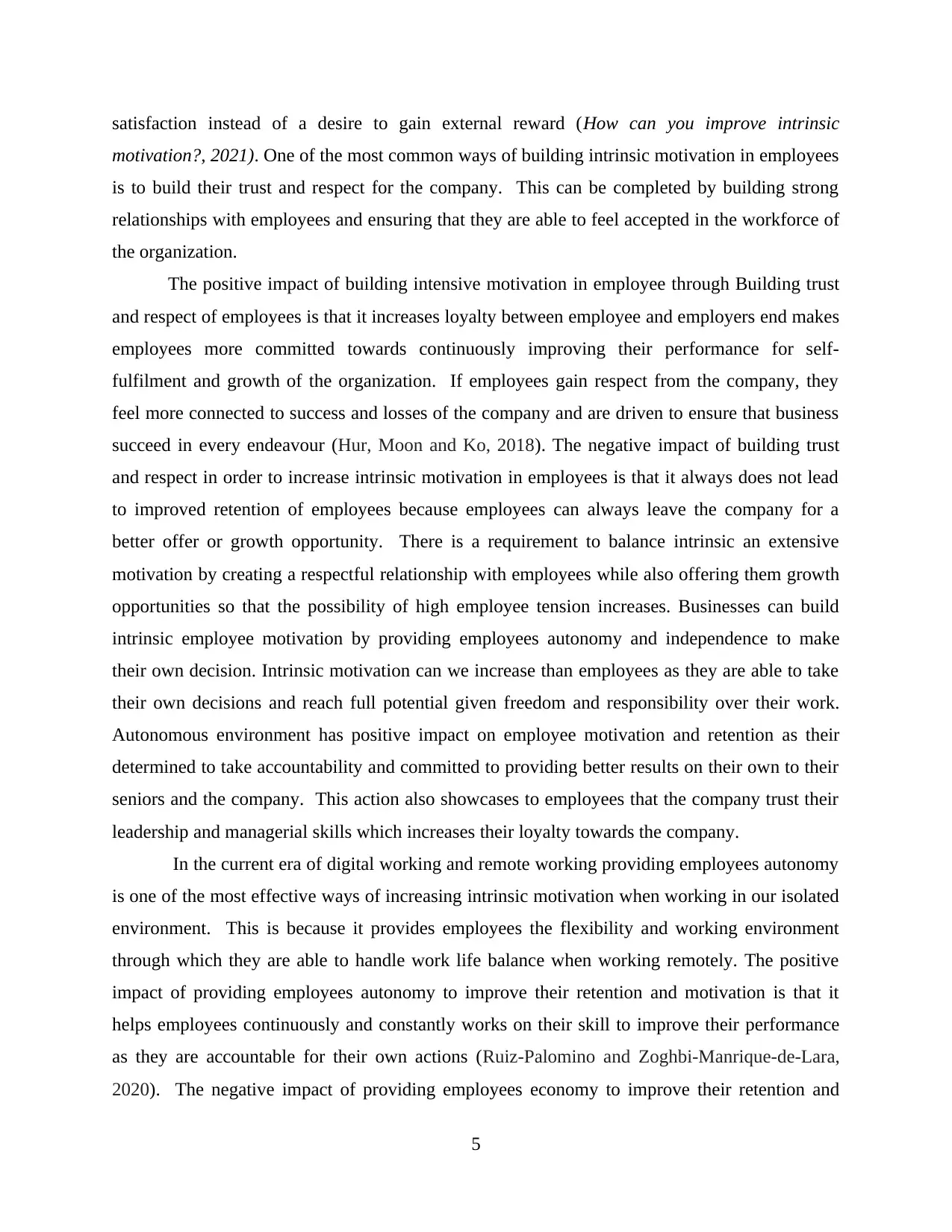
satisfaction instead of a desire to gain external reward (How can you improve intrinsic
motivation?, 2021). One of the most common ways of building intrinsic motivation in employees
is to build their trust and respect for the company. This can be completed by building strong
relationships with employees and ensuring that they are able to feel accepted in the workforce of
the organization.
The positive impact of building intensive motivation in employee through Building trust
and respect of employees is that it increases loyalty between employee and employers end makes
employees more committed towards continuously improving their performance for self-
fulfilment and growth of the organization. If employees gain respect from the company, they
feel more connected to success and losses of the company and are driven to ensure that business
succeed in every endeavour (Hur, Moon and Ko, 2018). The negative impact of building trust
and respect in order to increase intrinsic motivation in employees is that it always does not lead
to improved retention of employees because employees can always leave the company for a
better offer or growth opportunity. There is a requirement to balance intrinsic an extensive
motivation by creating a respectful relationship with employees while also offering them growth
opportunities so that the possibility of high employee tension increases. Businesses can build
intrinsic employee motivation by providing employees autonomy and independence to make
their own decision. Intrinsic motivation can we increase than employees as they are able to take
their own decisions and reach full potential given freedom and responsibility over their work.
Autonomous environment has positive impact on employee motivation and retention as their
determined to take accountability and committed to providing better results on their own to their
seniors and the company. This action also showcases to employees that the company trust their
leadership and managerial skills which increases their loyalty towards the company.
In the current era of digital working and remote working providing employees autonomy
is one of the most effective ways of increasing intrinsic motivation when working in our isolated
environment. This is because it provides employees the flexibility and working environment
through which they are able to handle work life balance when working remotely. The positive
impact of providing employees autonomy to improve their retention and motivation is that it
helps employees continuously and constantly works on their skill to improve their performance
as they are accountable for their own actions (Ruiz-Palomino and Zoghbi-Manrique-de-Lara,
2020). The negative impact of providing employees economy to improve their retention and
5
motivation?, 2021). One of the most common ways of building intrinsic motivation in employees
is to build their trust and respect for the company. This can be completed by building strong
relationships with employees and ensuring that they are able to feel accepted in the workforce of
the organization.
The positive impact of building intensive motivation in employee through Building trust
and respect of employees is that it increases loyalty between employee and employers end makes
employees more committed towards continuously improving their performance for self-
fulfilment and growth of the organization. If employees gain respect from the company, they
feel more connected to success and losses of the company and are driven to ensure that business
succeed in every endeavour (Hur, Moon and Ko, 2018). The negative impact of building trust
and respect in order to increase intrinsic motivation in employees is that it always does not lead
to improved retention of employees because employees can always leave the company for a
better offer or growth opportunity. There is a requirement to balance intrinsic an extensive
motivation by creating a respectful relationship with employees while also offering them growth
opportunities so that the possibility of high employee tension increases. Businesses can build
intrinsic employee motivation by providing employees autonomy and independence to make
their own decision. Intrinsic motivation can we increase than employees as they are able to take
their own decisions and reach full potential given freedom and responsibility over their work.
Autonomous environment has positive impact on employee motivation and retention as their
determined to take accountability and committed to providing better results on their own to their
seniors and the company. This action also showcases to employees that the company trust their
leadership and managerial skills which increases their loyalty towards the company.
In the current era of digital working and remote working providing employees autonomy
is one of the most effective ways of increasing intrinsic motivation when working in our isolated
environment. This is because it provides employees the flexibility and working environment
through which they are able to handle work life balance when working remotely. The positive
impact of providing employees autonomy to improve their retention and motivation is that it
helps employees continuously and constantly works on their skill to improve their performance
as they are accountable for their own actions (Ruiz-Palomino and Zoghbi-Manrique-de-Lara,
2020). The negative impact of providing employees economy to improve their retention and
5
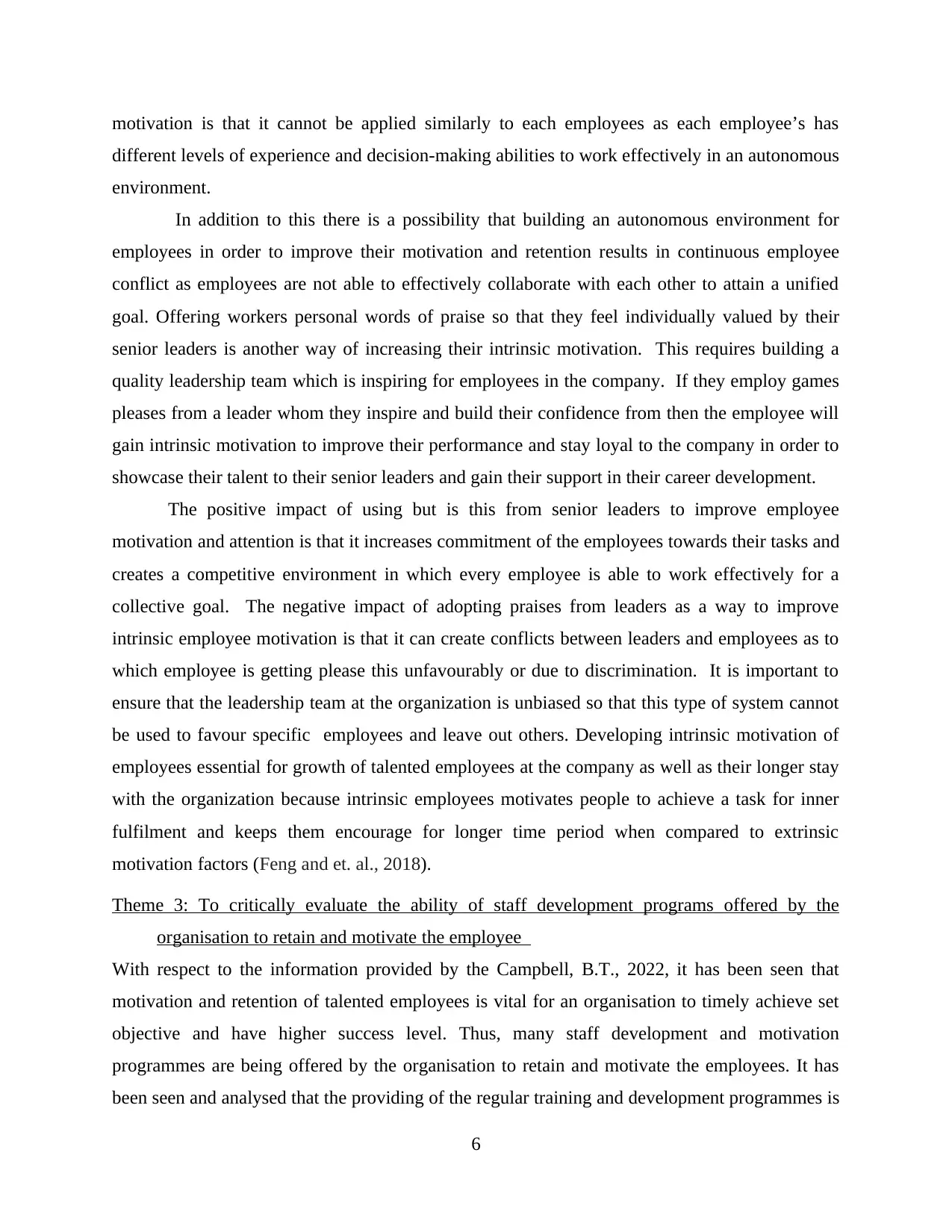
motivation is that it cannot be applied similarly to each employees as each employee’s has
different levels of experience and decision-making abilities to work effectively in an autonomous
environment.
In addition to this there is a possibility that building an autonomous environment for
employees in order to improve their motivation and retention results in continuous employee
conflict as employees are not able to effectively collaborate with each other to attain a unified
goal. Offering workers personal words of praise so that they feel individually valued by their
senior leaders is another way of increasing their intrinsic motivation. This requires building a
quality leadership team which is inspiring for employees in the company. If they employ games
pleases from a leader whom they inspire and build their confidence from then the employee will
gain intrinsic motivation to improve their performance and stay loyal to the company in order to
showcase their talent to their senior leaders and gain their support in their career development.
The positive impact of using but is this from senior leaders to improve employee
motivation and attention is that it increases commitment of the employees towards their tasks and
creates a competitive environment in which every employee is able to work effectively for a
collective goal. The negative impact of adopting praises from leaders as a way to improve
intrinsic employee motivation is that it can create conflicts between leaders and employees as to
which employee is getting please this unfavourably or due to discrimination. It is important to
ensure that the leadership team at the organization is unbiased so that this type of system cannot
be used to favour specific employees and leave out others. Developing intrinsic motivation of
employees essential for growth of talented employees at the company as well as their longer stay
with the organization because intrinsic employees motivates people to achieve a task for inner
fulfilment and keeps them encourage for longer time period when compared to extrinsic
motivation factors (Feng and et. al., 2018).
Theme 3: To critically evaluate the ability of staff development programs offered by the
organisation to retain and motivate the employee
With respect to the information provided by the Campbell, B.T., 2022, it has been seen that
motivation and retention of talented employees is vital for an organisation to timely achieve set
objective and have higher success level. Thus, many staff development and motivation
programmes are being offered by the organisation to retain and motivate the employees. It has
been seen and analysed that the providing of the regular training and development programmes is
6
different levels of experience and decision-making abilities to work effectively in an autonomous
environment.
In addition to this there is a possibility that building an autonomous environment for
employees in order to improve their motivation and retention results in continuous employee
conflict as employees are not able to effectively collaborate with each other to attain a unified
goal. Offering workers personal words of praise so that they feel individually valued by their
senior leaders is another way of increasing their intrinsic motivation. This requires building a
quality leadership team which is inspiring for employees in the company. If they employ games
pleases from a leader whom they inspire and build their confidence from then the employee will
gain intrinsic motivation to improve their performance and stay loyal to the company in order to
showcase their talent to their senior leaders and gain their support in their career development.
The positive impact of using but is this from senior leaders to improve employee
motivation and attention is that it increases commitment of the employees towards their tasks and
creates a competitive environment in which every employee is able to work effectively for a
collective goal. The negative impact of adopting praises from leaders as a way to improve
intrinsic employee motivation is that it can create conflicts between leaders and employees as to
which employee is getting please this unfavourably or due to discrimination. It is important to
ensure that the leadership team at the organization is unbiased so that this type of system cannot
be used to favour specific employees and leave out others. Developing intrinsic motivation of
employees essential for growth of talented employees at the company as well as their longer stay
with the organization because intrinsic employees motivates people to achieve a task for inner
fulfilment and keeps them encourage for longer time period when compared to extrinsic
motivation factors (Feng and et. al., 2018).
Theme 3: To critically evaluate the ability of staff development programs offered by the
organisation to retain and motivate the employee
With respect to the information provided by the Campbell, B.T., 2022, it has been seen that
motivation and retention of talented employees is vital for an organisation to timely achieve set
objective and have higher success level. Thus, many staff development and motivation
programmes are being offered by the organisation to retain and motivate the employees. It has
been seen and analysed that the providing of the regular training and development programmes is
6
⊘ This is a preview!⊘
Do you want full access?
Subscribe today to unlock all pages.

Trusted by 1+ million students worldwide
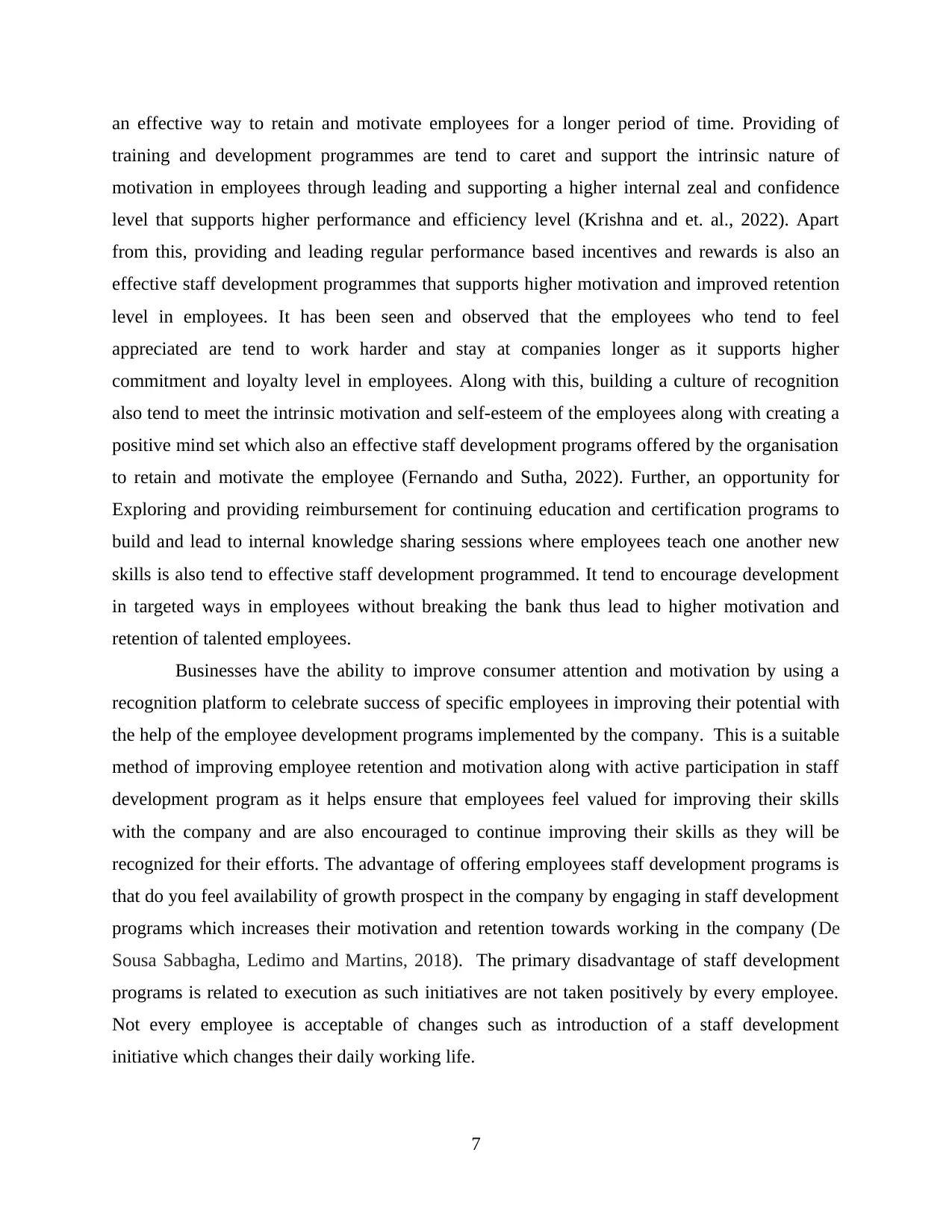
an effective way to retain and motivate employees for a longer period of time. Providing of
training and development programmes are tend to caret and support the intrinsic nature of
motivation in employees through leading and supporting a higher internal zeal and confidence
level that supports higher performance and efficiency level (Krishna and et. al., 2022). Apart
from this, providing and leading regular performance based incentives and rewards is also an
effective staff development programmes that supports higher motivation and improved retention
level in employees. It has been seen and observed that the employees who tend to feel
appreciated are tend to work harder and stay at companies longer as it supports higher
commitment and loyalty level in employees. Along with this, building a culture of recognition
also tend to meet the intrinsic motivation and self-esteem of the employees along with creating a
positive mind set which also an effective staff development programs offered by the organisation
to retain and motivate the employee (Fernando and Sutha, 2022). Further, an opportunity for
Exploring and providing reimbursement for continuing education and certification programs to
build and lead to internal knowledge sharing sessions where employees teach one another new
skills is also tend to effective staff development programmed. It tend to encourage development
in targeted ways in employees without breaking the bank thus lead to higher motivation and
retention of talented employees.
Businesses have the ability to improve consumer attention and motivation by using a
recognition platform to celebrate success of specific employees in improving their potential with
the help of the employee development programs implemented by the company. This is a suitable
method of improving employee retention and motivation along with active participation in staff
development program as it helps ensure that employees feel valued for improving their skills
with the company and are also encouraged to continue improving their skills as they will be
recognized for their efforts. The advantage of offering employees staff development programs is
that do you feel availability of growth prospect in the company by engaging in staff development
programs which increases their motivation and retention towards working in the company (De
Sousa Sabbagha, Ledimo and Martins, 2018). The primary disadvantage of staff development
programs is related to execution as such initiatives are not taken positively by every employee.
Not every employee is acceptable of changes such as introduction of a staff development
initiative which changes their daily working life.
7
training and development programmes are tend to caret and support the intrinsic nature of
motivation in employees through leading and supporting a higher internal zeal and confidence
level that supports higher performance and efficiency level (Krishna and et. al., 2022). Apart
from this, providing and leading regular performance based incentives and rewards is also an
effective staff development programmes that supports higher motivation and improved retention
level in employees. It has been seen and observed that the employees who tend to feel
appreciated are tend to work harder and stay at companies longer as it supports higher
commitment and loyalty level in employees. Along with this, building a culture of recognition
also tend to meet the intrinsic motivation and self-esteem of the employees along with creating a
positive mind set which also an effective staff development programs offered by the organisation
to retain and motivate the employee (Fernando and Sutha, 2022). Further, an opportunity for
Exploring and providing reimbursement for continuing education and certification programs to
build and lead to internal knowledge sharing sessions where employees teach one another new
skills is also tend to effective staff development programmed. It tend to encourage development
in targeted ways in employees without breaking the bank thus lead to higher motivation and
retention of talented employees.
Businesses have the ability to improve consumer attention and motivation by using a
recognition platform to celebrate success of specific employees in improving their potential with
the help of the employee development programs implemented by the company. This is a suitable
method of improving employee retention and motivation along with active participation in staff
development program as it helps ensure that employees feel valued for improving their skills
with the company and are also encouraged to continue improving their skills as they will be
recognized for their efforts. The advantage of offering employees staff development programs is
that do you feel availability of growth prospect in the company by engaging in staff development
programs which increases their motivation and retention towards working in the company (De
Sousa Sabbagha, Ledimo and Martins, 2018). The primary disadvantage of staff development
programs is related to execution as such initiatives are not taken positively by every employee.
Not every employee is acceptable of changes such as introduction of a staff development
initiative which changes their daily working life.
7
Paraphrase This Document
Need a fresh take? Get an instant paraphrase of this document with our AI Paraphraser
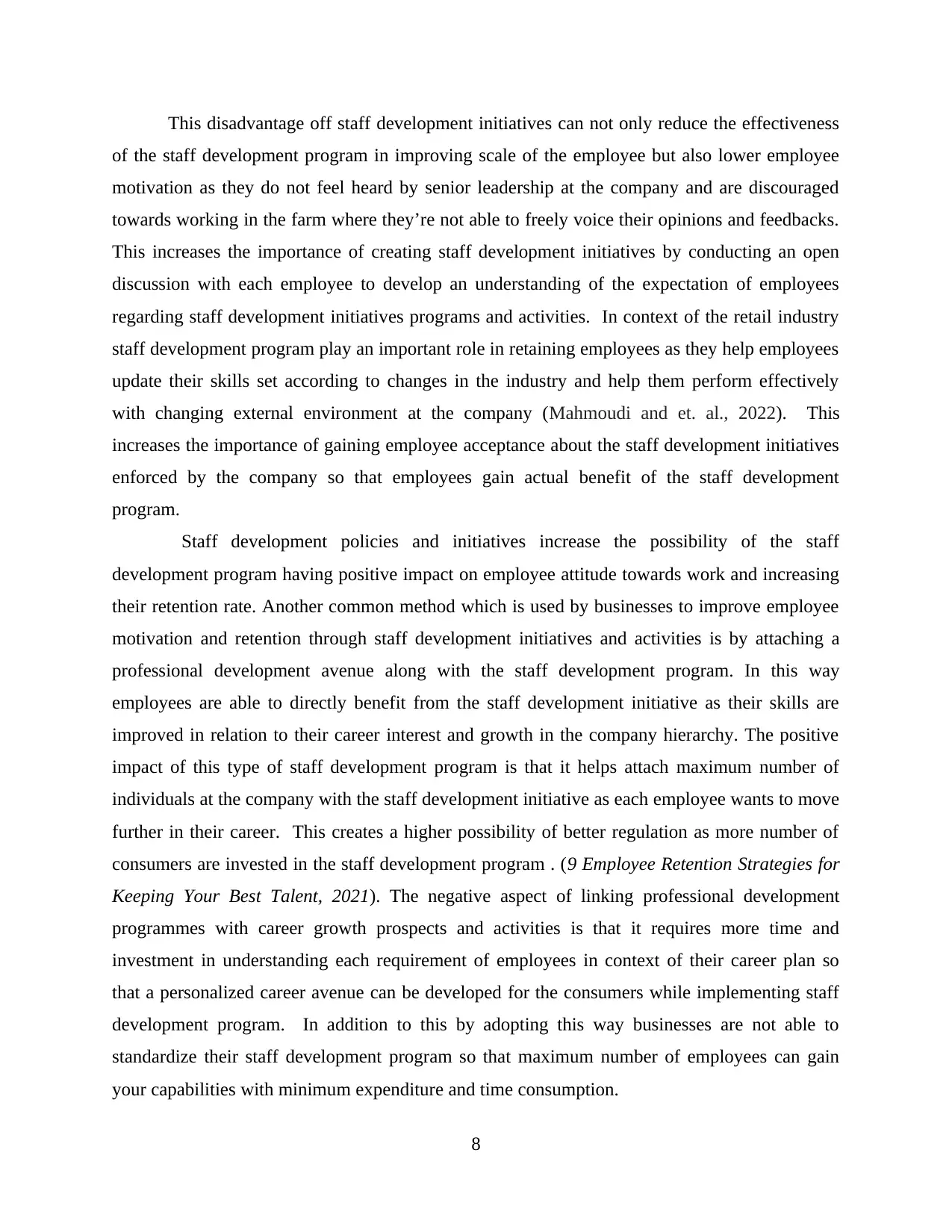
This disadvantage off staff development initiatives can not only reduce the effectiveness
of the staff development program in improving scale of the employee but also lower employee
motivation as they do not feel heard by senior leadership at the company and are discouraged
towards working in the farm where they’re not able to freely voice their opinions and feedbacks.
This increases the importance of creating staff development initiatives by conducting an open
discussion with each employee to develop an understanding of the expectation of employees
regarding staff development initiatives programs and activities. In context of the retail industry
staff development program play an important role in retaining employees as they help employees
update their skills set according to changes in the industry and help them perform effectively
with changing external environment at the company (Mahmoudi and et. al., 2022). This
increases the importance of gaining employee acceptance about the staff development initiatives
enforced by the company so that employees gain actual benefit of the staff development
program.
Staff development policies and initiatives increase the possibility of the staff
development program having positive impact on employee attitude towards work and increasing
their retention rate. Another common method which is used by businesses to improve employee
motivation and retention through staff development initiatives and activities is by attaching a
professional development avenue along with the staff development program. In this way
employees are able to directly benefit from the staff development initiative as their skills are
improved in relation to their career interest and growth in the company hierarchy. The positive
impact of this type of staff development program is that it helps attach maximum number of
individuals at the company with the staff development initiative as each employee wants to move
further in their career. This creates a higher possibility of better regulation as more number of
consumers are invested in the staff development program . (9 Employee Retention Strategies for
Keeping Your Best Talent, 2021). The negative aspect of linking professional development
programmes with career growth prospects and activities is that it requires more time and
investment in understanding each requirement of employees in context of their career plan so
that a personalized career avenue can be developed for the consumers while implementing staff
development program. In addition to this by adopting this way businesses are not able to
standardize their staff development program so that maximum number of employees can gain
your capabilities with minimum expenditure and time consumption.
8
of the staff development program in improving scale of the employee but also lower employee
motivation as they do not feel heard by senior leadership at the company and are discouraged
towards working in the farm where they’re not able to freely voice their opinions and feedbacks.
This increases the importance of creating staff development initiatives by conducting an open
discussion with each employee to develop an understanding of the expectation of employees
regarding staff development initiatives programs and activities. In context of the retail industry
staff development program play an important role in retaining employees as they help employees
update their skills set according to changes in the industry and help them perform effectively
with changing external environment at the company (Mahmoudi and et. al., 2022). This
increases the importance of gaining employee acceptance about the staff development initiatives
enforced by the company so that employees gain actual benefit of the staff development
program.
Staff development policies and initiatives increase the possibility of the staff
development program having positive impact on employee attitude towards work and increasing
their retention rate. Another common method which is used by businesses to improve employee
motivation and retention through staff development initiatives and activities is by attaching a
professional development avenue along with the staff development program. In this way
employees are able to directly benefit from the staff development initiative as their skills are
improved in relation to their career interest and growth in the company hierarchy. The positive
impact of this type of staff development program is that it helps attach maximum number of
individuals at the company with the staff development initiative as each employee wants to move
further in their career. This creates a higher possibility of better regulation as more number of
consumers are invested in the staff development program . (9 Employee Retention Strategies for
Keeping Your Best Talent, 2021). The negative aspect of linking professional development
programmes with career growth prospects and activities is that it requires more time and
investment in understanding each requirement of employees in context of their career plan so
that a personalized career avenue can be developed for the consumers while implementing staff
development program. In addition to this by adopting this way businesses are not able to
standardize their staff development program so that maximum number of employees can gain
your capabilities with minimum expenditure and time consumption.
8
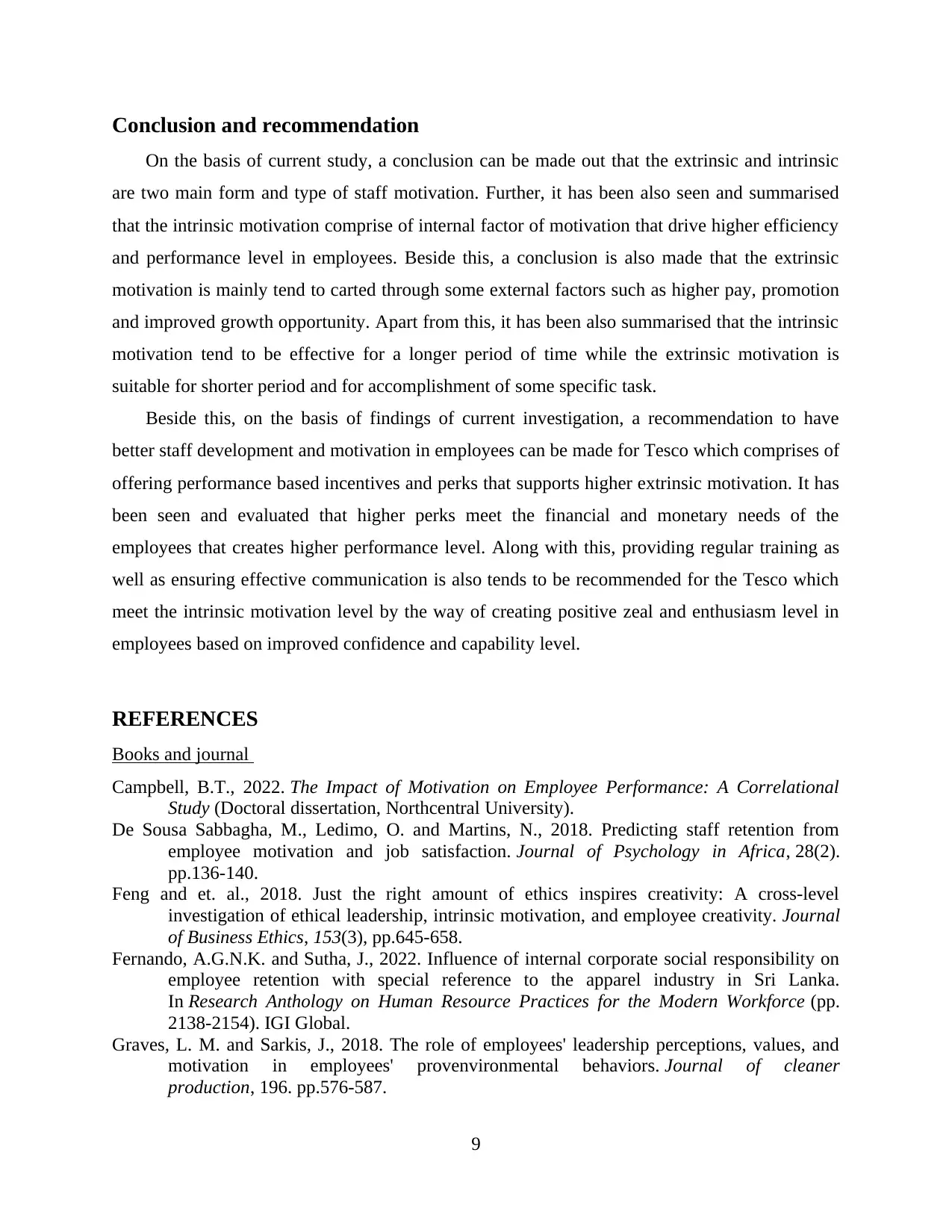
Conclusion and recommendation
On the basis of current study, a conclusion can be made out that the extrinsic and intrinsic
are two main form and type of staff motivation. Further, it has been also seen and summarised
that the intrinsic motivation comprise of internal factor of motivation that drive higher efficiency
and performance level in employees. Beside this, a conclusion is also made that the extrinsic
motivation is mainly tend to carted through some external factors such as higher pay, promotion
and improved growth opportunity. Apart from this, it has been also summarised that the intrinsic
motivation tend to be effective for a longer period of time while the extrinsic motivation is
suitable for shorter period and for accomplishment of some specific task.
Beside this, on the basis of findings of current investigation, a recommendation to have
better staff development and motivation in employees can be made for Tesco which comprises of
offering performance based incentives and perks that supports higher extrinsic motivation. It has
been seen and evaluated that higher perks meet the financial and monetary needs of the
employees that creates higher performance level. Along with this, providing regular training as
well as ensuring effective communication is also tends to be recommended for the Tesco which
meet the intrinsic motivation level by the way of creating positive zeal and enthusiasm level in
employees based on improved confidence and capability level.
REFERENCES
Books and journal
Campbell, B.T., 2022. The Impact of Motivation on Employee Performance: A Correlational
Study (Doctoral dissertation, Northcentral University).
De Sousa Sabbagha, M., Ledimo, O. and Martins, N., 2018. Predicting staff retention from
employee motivation and job satisfaction. Journal of Psychology in Africa, 28(2).
pp.136-140.
Feng and et. al., 2018. Just the right amount of ethics inspires creativity: A cross-level
investigation of ethical leadership, intrinsic motivation, and employee creativity. Journal
of Business Ethics, 153(3), pp.645-658.
Fernando, A.G.N.K. and Sutha, J., 2022. Influence of internal corporate social responsibility on
employee retention with special reference to the apparel industry in Sri Lanka.
In Research Anthology on Human Resource Practices for the Modern Workforce (pp.
2138-2154). IGI Global.
Graves, L. M. and Sarkis, J., 2018. The role of employees' leadership perceptions, values, and
motivation in employees' provenvironmental behaviors. Journal of cleaner
production, 196. pp.576-587.
9
On the basis of current study, a conclusion can be made out that the extrinsic and intrinsic
are two main form and type of staff motivation. Further, it has been also seen and summarised
that the intrinsic motivation comprise of internal factor of motivation that drive higher efficiency
and performance level in employees. Beside this, a conclusion is also made that the extrinsic
motivation is mainly tend to carted through some external factors such as higher pay, promotion
and improved growth opportunity. Apart from this, it has been also summarised that the intrinsic
motivation tend to be effective for a longer period of time while the extrinsic motivation is
suitable for shorter period and for accomplishment of some specific task.
Beside this, on the basis of findings of current investigation, a recommendation to have
better staff development and motivation in employees can be made for Tesco which comprises of
offering performance based incentives and perks that supports higher extrinsic motivation. It has
been seen and evaluated that higher perks meet the financial and monetary needs of the
employees that creates higher performance level. Along with this, providing regular training as
well as ensuring effective communication is also tends to be recommended for the Tesco which
meet the intrinsic motivation level by the way of creating positive zeal and enthusiasm level in
employees based on improved confidence and capability level.
REFERENCES
Books and journal
Campbell, B.T., 2022. The Impact of Motivation on Employee Performance: A Correlational
Study (Doctoral dissertation, Northcentral University).
De Sousa Sabbagha, M., Ledimo, O. and Martins, N., 2018. Predicting staff retention from
employee motivation and job satisfaction. Journal of Psychology in Africa, 28(2).
pp.136-140.
Feng and et. al., 2018. Just the right amount of ethics inspires creativity: A cross-level
investigation of ethical leadership, intrinsic motivation, and employee creativity. Journal
of Business Ethics, 153(3), pp.645-658.
Fernando, A.G.N.K. and Sutha, J., 2022. Influence of internal corporate social responsibility on
employee retention with special reference to the apparel industry in Sri Lanka.
In Research Anthology on Human Resource Practices for the Modern Workforce (pp.
2138-2154). IGI Global.
Graves, L. M. and Sarkis, J., 2018. The role of employees' leadership perceptions, values, and
motivation in employees' provenvironmental behaviors. Journal of cleaner
production, 196. pp.576-587.
9
⊘ This is a preview!⊘
Do you want full access?
Subscribe today to unlock all pages.

Trusted by 1+ million students worldwide
1 out of 13
Related Documents
Your All-in-One AI-Powered Toolkit for Academic Success.
+13062052269
info@desklib.com
Available 24*7 on WhatsApp / Email
![[object Object]](/_next/static/media/star-bottom.7253800d.svg)
Unlock your academic potential
Copyright © 2020–2025 A2Z Services. All Rights Reserved. Developed and managed by ZUCOL.



